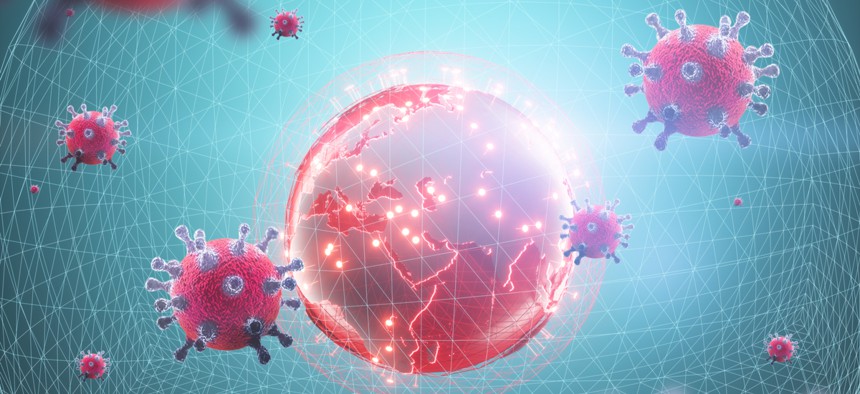Pentagon Scientists Seek Device to Detect COVID-19 in the Air

Marko Aliaksandr/Shutterstock
The Pentagon’s research and development arm is looking for new ways to detect coronavirus.
The U.S. has been fighting the novel coronavirus from a defensive posture—wearing masks, quarantining and testing and contact tracing when symptoms arise, at best. But the Defense Department’s team of mad scientists want to know if they can detect COVID-19 in the air and proactively tell people to avoid a specific location.
As part of its Disruption Opportunities, the Defense Advanced Research Projects Agency, or DARPA, put out a call for “innovative basic or applied research concepts in the technical domain of environmental pathogen sensing,” according to the opportunity notice. That research will be used to forward development of a sensitive sensor capable of detecting SARS-CoV-2—the technical name for the virus that results in a COVID-19 infection.
The SenSARS platform “could provide a new mechanism for public health monitoring,” including clearing public places like schools and government buildings as "safe" before being used.
“The ultimate goal of SenSARS is to develop a prototype sensor that can detect SARS-CoV-2 in the air with enough sensitivity, specificity, and speed to enable practical concepts of operation to be employed before infection can occur within an indoor environment,” the notice states.
Through the disruption opportunity, DARPA is looking for specific “signatures” of the virus that can be found in the air. Even if scientists can find and isolate those identifiers, developing a tool to accurately detect them will be a challenge.
“Environmental monitoring for pathogens has historically been, and continues to be, an extremely challenging area of study,” the notice states. “Techniques explored to date have included spectral techniques, affinity techniques, and sampling and assay techniques.”
To date, sensing options have offered a choice between accuracy and speed. The more accurate tests require a sample to be taken to a lab, which can then take “10s of minutes to days” for results.
“On the other hand, current air-breathing environmental sensors using optical techniques offer fast detection times but limited ability to discriminate between benign and pathogenic material, such as the SARS-CoV-2 virus,” according to the notice.
That said, DARPA officials have been encouraged by new research into several technologies and techniques, including “radiofrequency vibrometry, improvements in terahertz sources and sensors, improvements in mass spectrometric techniques, emerging immunosensing techniques, electrochemical detection methods, and advances in signal analysis using machine learning approaches.”
The notice proposes three use cases as examples:
- An office space measuring 50 cubic meters.
- A conference room or classroom measuring 300 cubic meters.
- Central monitoring of a building up to 10 stories tall.
The development process will be split into two phases, each limited to nine months and $500,000. In Phase I, researchers will work on identifying various SARS-CoV-2 signatures and the quality of each as an airborne identifier. Phase II will focus on refining those signatures and building a working prototype.



